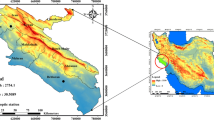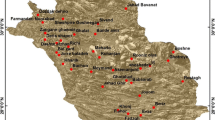Abstract
Though most factors that trigger droughts cannot be prevented, accurate, relevant and timely forecasts can be used to mitigate their impacts. Drought forecasts must define the droughts severity, onset, cessation, duration and spatial distribution. Given the high probability of droughts occurrence in Kenya, her heavy reliance on rain-fed agriculture and lack of effective drought mitigation strategies, the country is highly vulnerable to impacts of droughts. Current drought forecasting approaches used in Kenya are not able to provide short and long term forecasts and they fall short of providing the severity of the drought. In this paper, a combination of Artificial Neural Networks and Effective Drought Index is presented as a potential candidate for addressing these drawbacks. This is demonstrated using forecasting models that were built using weather data for thirty years for four weather stations (representing 3 agro-ecological zones) in Kenya. Experiments varying various input/output combinations were carried out and drought forecasting network models were implemented in Matrix Laboratory’s (MATLAB) Neural Network Toolbox. The models incorporate forecasted rainfall values in order to mitigate for unexpected extreme climate variations. With accuracies as high as 98 %, the solution is a great enhancement to the solutions currently in use in Kenya.










Similar content being viewed by others
References
Antonić O, Josip K, Antun M, Dragan B (2001) Ecol Model 138:255–263
Armstrong S, Mark C, Randolph K, Dan M (2011) World Disasters Report – Focus on Hunger and Malnutrition. International Federation of Red Cross and Red Crescent Societies. International Federation of Red Cross and Red Crescent Societies, Geneva
ASCE Task Committee On Application Of Artificial Neural Networks In Hydrology (2000) Artificial Neural Networks in Hydrology: II. Hydrologic Applications. J Hydrol Eng 5:115–123
Bodri L, Cermak V (2001) Prediction of extreme precipitation using a neural network: application to summer flood occurrence in Moravia. Journal of Environmental Informatics 45:155–167
Byun H, Wilhite DA (1999) Objective quantification of drought severity and duration. J Clim 12:2747–2756
CERF (Central Emergency Response Fund) (2009) CERF funds jump start emergency aid operations in Kenya. United Nations Economic Commission for Africa. Addis Ababa, Ethiopia
Chang-Shian C, Boris P, Chen F, Chou N, Chao-Chung Y (2010) Development and application of a decision group Back-Propagation Neural Network for flood forecasting. J Hydrol 385:173–182
Collins A, Nick M, Michele M, Anne M, Maarten VA (2009) World Disasters Report – Focus on Early Warning, Action, 1st edn. International Federation of Red Cross and Red Crescent Societies, Geneva
Deely S, David D, Jorgelina H, Cassidy J (2010) World Disasters Report – Focus on Urban Risk, 1st edn. International Federation of Red Cross and Red Crescent Societies, Geneva
Demuth, H., Mark, B. and Martin, H. 2009. MATLAB Neural Network Toolbox – User’s Guide. 6
Dracup JA, KS L, KS L, Paulson EG Jr (1980) On the definition of droughts. Water Resour Res 16:289–296
Elsa E, Moreira C, Coelho A, Paulo AA (2008) SPI-Based Drought Category Predication Using Loglinear Models. J Hydrol 354:116–130
Freitas, M.A.S. and Billib, M.H.A. 1997. Drought prediction and characteristic analysis in semiarid Cearâ, northeast Brazil. Sustainability of Water Resources under Increasing Uncertainty, Anonymous IAHS, No. 240, , 105.
Huschke, R. E., 1970: Glossary of Meteorology. Amer. Meteor. Soc., 638 pp.
Kim D, Hi-Ryong B, Ki-Seon C (2009) Evaluation, modification, and application of the Effective Drought Index to 200-Year drought climatology of Seoul, Korea. J Hydrol 378:1–12
Kung H, Hua J, Chen C (2006) Drought forecast model and framework using wireless sensor networks. J Inf Sci Eng 22:751–769
Maier HR, Dandy GC (2000) Neural networks for the prediction and forecasting of water resources variables: a review of modelling issues and applications. Environ Model Softw 15(1):101–124
Masinde, M. and Bagula, A., 2011. The Role of ICTs in Quantifying the Severity and Duration of Climatic Variations – Kenya’s Case, Proceedings of ITU Kaleidoscope 2011: The Fully Networked Human? - Innovations for Future Networks and Services (K-2011), 12–14 December 2011, IEEE Xplore, pp. 1–8
Masinde M, Bagula A (2012) ITIKI: bridge between African indigenous knowledge and modern science of drought prediction. Knowl Manag Dev J 7(03):274–290
Mcculloch WS, Pitts W (1943) A logical calculus of the ideas imminent in nervous activity. Bull Math Biophys 5:115–133
Mckee TB, Doesken NJ, Kleist J (1993) The relationship of drought frequency and duration to time scales. In: 8th Conference on Applied Climatology, January. Anonymous American Meteorological Society, Boston, Massachusetts, pp 17–23
Mishra AK, Desai VR (2006) Drought Forecasting Using Fee-Forward Recursive Neural Network. Ecol Model 198:128–138
Mishra AK, Singn VP (2010) A Review of Drought Concepts. J Hydrol 391:202–216
Morid S, Smakhtin V, Bagherzadeh K (2007) Drought forecasting using artificial neural networks and time series of drought indices. Int J Climatol 27:2103–2111
Mutua, S., 2011. Strengthening Drought Early Warning At The Community and District Levels: Analysis Of Traditional Community Warning Systems In Wajir & Turkana
Mwagore D (2002) Land use in Kenya: The case for a national land use policy. Printfast Kenya Ltd., Nairobi
Palmer, W.C., 1965. Meteorological Drought. Research Paper 45. US Department of Commerce, Weather Bureau, Washington, DC, pp. 1–58.
Panu, U.S. and Sharma, T.C. 2002. Challenges in drought research: some perspectives and future directions. Hydrological Sciences-Journal .
Rumelhart DE, Hinton GE, Williams RJ (1986) “Learning internal representations by error propagation.” Parallel distributed processing, Vol. 1. MIT Press, Cambridge, pp 318–362
Shin HS, Salas JD (2000) Regional drought analysis based on neural networks. J Hydrol Eng 5(2):145–155
Weichert A, Burger G (1998) Linear versus nonlinear techniques in downscaling. Clim Res 10:83–93
Wells N, Goddard S, Hayes MJ (2004) A self-calibrating palmer drought severity index. J Clim 17:2335–2351
WHO Collaborating Centre For Research On The Epidemiology of Disasters (CRED), 2012-last update, Emergency Events Database (EM-DAT) [Homepage of Government of Belgium, for WHO], [Online]. Available: http://www.emdat.be/ [May/11, 2012].
Wilhite DA, Glantz MH (1985) Understanding the drought phenomenon: the role of definitions. Water International 10:111–120
Yin RK (1993) Applications of Case Study Research. Sage, Newbury Park
Acknowledgement
Special thanks to the Kenya Meteorological Department for providing the data set used in this research.
Author information
Authors and Affiliations
Corresponding author
Rights and permissions
About this article
Cite this article
Masinde, M. Artificial neural networks models for predicting effective drought index: Factoring effects of rainfall variability. Mitig Adapt Strateg Glob Change 19, 1139–1162 (2014). https://doi.org/10.1007/s11027-013-9464-0
Received:
Accepted:
Published:
Issue Date:
DOI: https://doi.org/10.1007/s11027-013-9464-0




